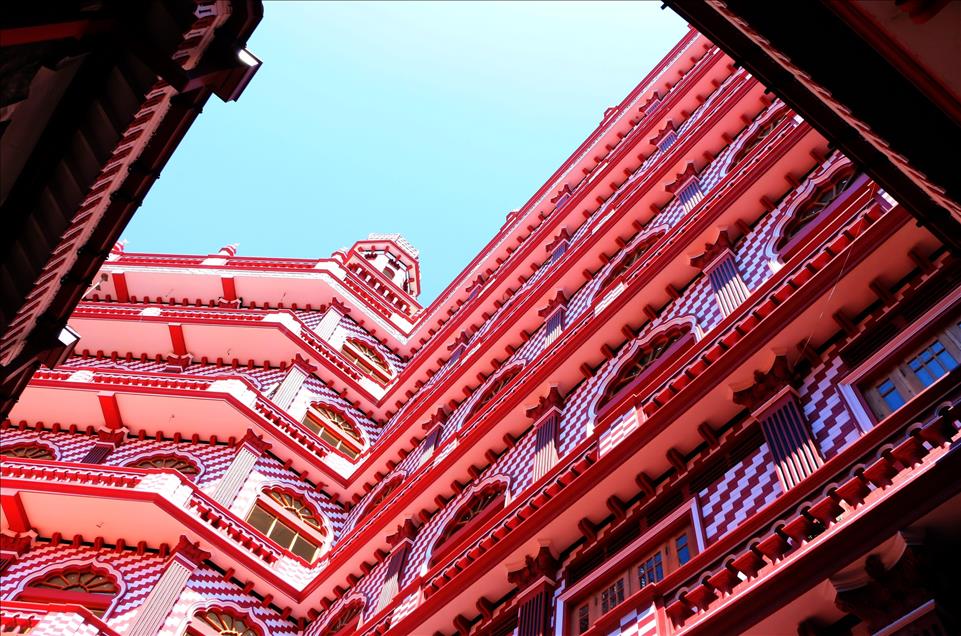Jami Ul-Alfar Mosque, commonly known as the "Red Mosque," is an iconic landmark situated in Colombo, the capital of Sri Lanka. Renowned for its striking architecture, historical significance, and religious importance, the mosque represents the cultural and spiritual influence of Islam in the region. Built in the early 20th century, it has evolved into both a spiritual hub for the local Muslim community and a popular tourist attraction. Located in Colombo's bustling Pettah district, the mosque is distinguished by its vibrant red-and-white geometric patterns and is considered one of the finest examples of Islamic architecture in Sri Lanka.

Jami Ul-Alfar Mosque: The Red Mosque
HISTORICAL BACKGROUND AND CONSTRUCTION
Jami Ul-Alfar Mosque was constructed in 1908 to accommodate the growing needs of the Muslim population in the region. The mosque's construction was funded by local Muslim leaders and the broader community. Pettah, being the commercial heart of Colombo at the time, made the mosque a focal point not just for worship but also for community gathering and support.
The architectural design of the mosque combines elements of Islamic artistry with regional influences. The use of red and white bricks in the construction created a unique aesthetic, setting it apart from other mosques. Additionally, the mosque served as a navigational landmark for sailors approaching Pettah Port due to its prominent red hues and towering minarets, which could be seen from a considerable distance.
ARCHITECTURAL FEATURES
The architecture of Jami Ul-Alfar Mosque masterfully integrates Islamic artistic traditions with local Sri Lankan influences.
- Facade and Colors: The most striking feature is its red-and-white patterned exterior. The symmetrical, repeating geometric motifs reflect the elegance and discipline of Islamic art.
- Domes and Minarets: The mosque's domes and minarets are designed in alignment with traditional Islamic architecture while accommodating the tropical climate of Sri Lanka.
- Interior Design: Inside, the mosque maintains a serene and minimalist aesthetic. The spacious prayer hall is capable of accommodating a large congregation, and the use of natural lighting enhances the tranquil atmosphere.
- Material and Craftsmanship: High-quality materials and meticulous craftsmanship have ensured the mosque's durability and visual appeal over time.

Jami Ul-Alfar Mosque: The Red Mosque
RELIGIOUS AND CULTURAL SIGNIFICANCE
Jami Ul-Alfar Mosque holds a central place in the spiritual lives of Colombo's Muslim community. Beyond daily prayers, the mosque is a venue for religious education, cultural gatherings, and communal events. It symbolizes the unity and resilience of the Muslim population in Sri Lanka.
Additionally, the mosque is a major cultural landmark, drawing visitors from around the world. Its unique architecture and historical legacy attract tourists of all backgrounds, fostering cross-cultural appreciation and understanding. As a result, the mosque plays a dual role as both a religious sanctuary and a bridge for cultural exchange.
GLOBAL RECOGNITION AND TOURIST APPEAL
Jami Ul-Alfar Mosque is among the most visited sites in Colombo, celebrated for its architectural grandeur and historical relevance. Tourists flock to explore its intricate designs and learn about its role in Sri Lanka's cultural mosaic. Its global reputation as an architectural masterpiece has also made it a symbol of Islamic heritage. The mosque's popularity has contributed to increased economic activity in its surrounding area, further embedding it as a vital part of Colombo's social and cultural fabric.
Jami Ul-Alfar Mosque is not merely a place of worship but a testament to the rich cultural and religious diversity of Sri Lanka. Its vibrant history, unique architecture, and spiritual significance make it a landmark of both local and international importance. As a cultural and historical treasure, it stands as a vivid reminder of the harmonious blending of tradition and modernity, inviting visitors to appreciate its beauty and heritage. The Red Mosque, with its timeless charm, continues to serve as a symbol of faith, community, and cultural pride, underscoring Sri Lanka's commitment to preserving its diverse heritage.

